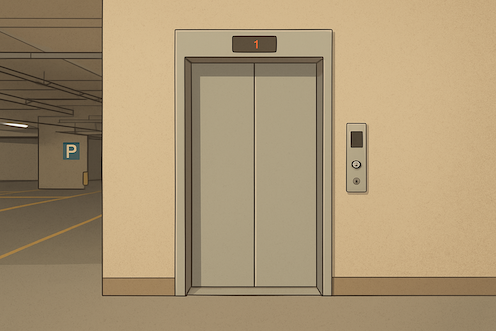Ms. Chen, an owner of a high-end community in Shanghai, recently discovered that nearly one-third of the property management fees she pays each month are spent on the maintenance of the underground garage elevator. This ten-year-old high-rise residence is equipped with an observation elevator that connects the underground parking lot on the third floor with the ground level. However, this elevator has now become the "joke bearer" among the residents: it gets flooded and short-circuited during rainy days, stops operating in summer due to high temperatures, freezes and gets stuck in winter, and even caused an incident where a car owner was trapped in the elevator and missed their flight.

According to the "2023 Underground Space Development Report" by the China Urban Planning and Design Institute, the average depth of underground garages in first-tier cities in China is -12 meters. However, the failure rate of the supporting elevators is 2.3 times that of the elevators on the ground. In the complaint statistics of a leading property company, "abnormal operation of the garage elevators" has consistently ranked first among facility-related complaints for two consecutive years. Especially during the rainy season and extreme weather conditions, the complaint volume will increase by 300%.
"Many people think that elevators are merely tools for going up and down floors, but they fail to realize that in underground spaces, they are the lifeline connecting the ground and parking spaces," pointed out Mr. Zhang, an expert in elevator safety. "When the depth of the garage exceeds -8 meters or the daily usage frequency exceeds 200 times, the waterproof, heat dissipation and emergency systems of the elevator must undergo special design."
The situation in Ms. Chen's neighborhood is highly representative. This elevator was put into use in 2015, and its original design standard only met the basic requirement of "able to operate":
Insufficient waterproofing: It was designed with an IPX3 protection standard, which could only handle minor water splashes. During actual use, the drainage system in the underground garage and the elevator shaft were not physically isolated, resulting in 1.2 meters of water accumulation in the shaft during a super typhoon in 2020, and the control cabinet was completely damaged.
Defects in the cooling system: The garage temperature often reached above 40℃ in summer, and the original design's natural ventilation could not meet the cooling requirements. After continuous operation for 2 hours, the frequency converter would stop due to overheating protection, and a fault occurred on average once every 4 trips during peak hours.
The emergency function was merely a formality: Although it was equipped with an emergency call device, the property management's duty room was only staffed by one person 24 hours a day, and it was not linked with 119. In the winter of 2022, an elderly person was trapped in the elevator for 40 minutes. Finally, the family had to climb the fire escape from the 1st floor to the -3rd floor to rescue him.
"It's like driving a regular car into an off-road race track." Engineer Li Wei, who participated in the elevator renovation, explained, "The corrosive effect of the underground environment on the elevator is five times that of the ground. Humidity, temperature differences, and dust all accelerate the aging of the equipment. Industrial-grade protection standards must be adopted."
Under the collective pressure of the property owners' rights protection, the property management company finally initiated the elevator renovation project. The new plan specifically addresses three major pain points:
Waterproofing upgrade: Adopting an IPX5 protection level, adding an automatic drainage pump at the bottom of the shaft, and operating independently of the garage drainage system
Heat dissipation enhancement: Installing industrial air conditioners, laying insulation materials on the inner walls of the shaft, and using a sealed design for the control cabinet with an independent cooling channel
Emergency reconstruction: Upgrading the five-party communication system, connecting it to the property, fire protection, and elevator maintenance platforms, and installing emergency lighting and ventilation devices in the shaft
The renovation has achieved remarkable results: the failure rate has dropped from 8.7 times per month to 0.3 times, and the single repair cost has decreased from 4,200 yuan to 800 yuan. More importantly, the survey of property owners' satisfaction shows that 92% of the respondents believe that "the safety of the elevators has significantly improved". This data directly led to a 3,500 yuan increase in the price of each square meter of second-hand houses in the community.
Underground Elevator Buying Guide: Five Must-Know Truths
1. Waterproofing is not an optional feature but a standard requirement: Opt for a protection level of IPX4 or above. The shaft and the garage drainage must be physically isolated.
2. Heat dissipation determines service life: In humid southern regions, a forced cooling system must be equipped; in cold northern regions, an electric heating device should be added.
3. Load capacity needs to match the usage scenario: For residential garage elevators, a load capacity of 1000kg or above is recommended to avoid door lock failures due to overloading.
4. Maintenance contracts should be carefully reviewed: Clearly stipulate response time (recommend ≤ 30 minutes), spare parts supply cycle, and proportion of major repair costs.
5. Intelligent monitoring is a must-have: Install IoT sensors to monitor temperature, humidity, and operation frequency in real time, enabling preventive maintenance.
Now, when Ms. Chen stands in front of the newly renovated elevator and looks at the real-time operating data displayed on the electronic screen, she finally understands: The underground garage elevator is not just a simple transportation tool, but rather the "invisible infrastructure" of modern urban vertical transportation. It endures the harsh conditions of the underground space, connects the ground and underground living scenarios, and safeguards the safety bottom line of every car owner. In this era of seeking space underground, perhaps we should show more respect and attention to this "silent steel warrior".
